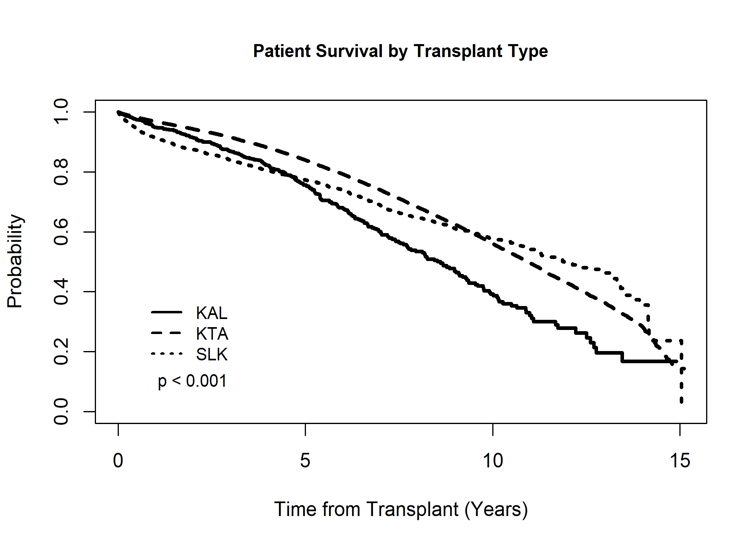Long-Term Kidney Graft Survival is Superior with Simultaneous-Liver Kidney (SLK) Transplants Than Kidney Alone (KA) or Kidney after Liver (KALi) Transplants in the United States
1University of Minnesota, Minneapolis, MN, 2M Health Fairview, Minneapolis, MN
Meeting: 2020 American Transplant Congress
Abstract number: LB-020
Keywords: Graft failure, Graft survival, Kidney, Kidney transplantation
Session Information
Session Name: Poster Session B: Late Breaking
Session Type: Poster Session
Date: Saturday, May 30, 2020
Session Time: 3:15pm-4:00pm
 Presentation Time: 3:30pm-4:00pm
Presentation Time: 3:30pm-4:00pm
Location: Virtual
*Purpose: There is a concern that SLK transplant recipients have worse outcomes resulting in poor utilization of the kidney donor pool. We utilized the Scientific Registry of Transplant Recipients (SRTR) database to compare the patient and kidney allograft survival by the type of transplant received.
*Methods: We analyzed adult primary kidney transplant recipients from July 2004 to December 2018. recipients were grouped according to transplant type: KA, SLK and KALi transplants. All recipients were immunosuppressed on tacrolimus and mycophenolate mofetil. Recipients of other solid-organ transplants were excluded. We generated Kaplan-Meier survival curves to ascertain the impact of transplant type on patient survival and death-censored kidney allograft survival. All analysis was performed in R, ver. 3.6.1.
*Results: 97,088 subjects received a kidney transplant over the study period: 92470 KA, 3684 SLK and 934 KALi. KALi recipients were older, more likely to be male and have hepatitis C whereas SLK recipients were less likely to have pre-transplant dialysis. At 10 years post-transplant, patient survival was significantly worse for KALi recipients compared to KA and SLK (Figure 1). Death-censored kidney allograft survival was similar until 5 years; survival curves then diverged with SLK patients showing superior graft survival compared to KA and KALi transplants (Figure 2). Due to severe non-proportional hazards, Cox PH regression was not performed for patient or graft survival.
*Conclusions: Long-term kidney transplant graft survival in SLK recipients is superior to KA or KALi recipients. Concerns regarding wasteful kidney organ allocation are unfounded and should not affect future policy discussions.
To cite this abstract in AMA style:
Lim N, Riad SM, Jackson S, Lake J. Long-Term Kidney Graft Survival is Superior with Simultaneous-Liver Kidney (SLK) Transplants Than Kidney Alone (KA) or Kidney after Liver (KALi) Transplants in the United States [abstract]. Am J Transplant. 2020; 20 (suppl 3). https://atcmeetingabstracts.com/abstract/long-term-kidney-graft-survival-is-superior-with-simultaneous-liver-kidney-slk-transplants-than-kidney-alone-ka-or-kidney-after-liver-kali-transplants-in-the-united-states/. Accessed January 1, 2026.« Back to 2020 American Transplant Congress


